MDF – Medium Density Fiberboard
Medium Density Fibreboard (MDF) is an engineered wood product with a smooth surface and uniform density core. MDF is made by breaking down hardwood or softwood residuals into wood fibres, combining it with wax and a resin binder and forming panels by applying high temperature and pressure.
Imagine if all of the sawdust was swept up from other wood product manufacturing processes, and then that sawdust was mixed with binders and pressed into large sheets the size of plywood. It’s not exactly the process they use to make MDF, but that gives you an idea of the makeup of the product.
Because it’s composed of such small wood fibers, there’s no wood grain in MDF. And because it’s pressed so hard at such high temperatures, there are no voids in MDF like you find in particle board. Here you can see the visible difference between particle board and MDF, with MDF on the top and particle board on the bottom.
Advantages of MDF
The surface of MDF is very smooth, and you don’t have to worry about knots on the surface.
Because it’s so smooth, it’s a great surface for painting. We recommend first priming with a quality oil-based primer. (Don’t use aerosol spray primers on MDF!! It just soaks right in, and is a huge waste of time and money. It will also cause the surface to become rough.)
Also because of its smoothness, MDF is a great substrate for veneer.
MDF is very consistent throughout, so cut edges appear smooth and won’t have voids or splinters.
Because of the smooth edges, you can use a router to create decorative edges.
The consistency and smoothness of MDF allows for easy cutting of detailed designs (such as scrolled or scalloped designs) using a scroll saw, band saw, or jigsaw.
Disadvantages of MDF
MDF is basically glorified particle board.
Just like particle board, MDF will soak up water and other liquids like a sponge and swell unless it’s very well sealed on all sides and edges with primer, paint, or another sealing product.
Because it consists of such fine particles, MDF doesn’t hold screws very well, and it’s very easy to strip the screw holes.
Because it’s so dense, MDF is very heavy. This can make it more difficult to work with, especially if you don’t have a helper who can help you lift and cut the large sheets.
MDF can’t be stained. Not only does it soak up stain like a sponge, but also because there’s no wood grain on MDF, it looks awful when it’s stained.
MDF contains VOCs (urea-formaldehyde). Off gassing can be greatly minimized (but probably not eliminated) if the MDF is encapsulated with primer, paint, etc., but care needs to be taken while cutting and sanding to avoid inhalation of the particles.
Applications of MDF
MDF is primarily used for interior applications, while Moisture Resistant MDF can be used in moisture prone areas such as kitchens, laundries and bathrooms.
Medium Density Fibreboard is able to be easily painted, cut, machined and cleanly drilled without splintering or chipping. These qualities confirm that MDF is an ideal product for applications like shop fitting or cabinet making especially in indoor furniture.
Post time: Jul-16-2020











